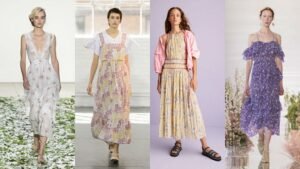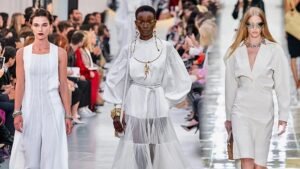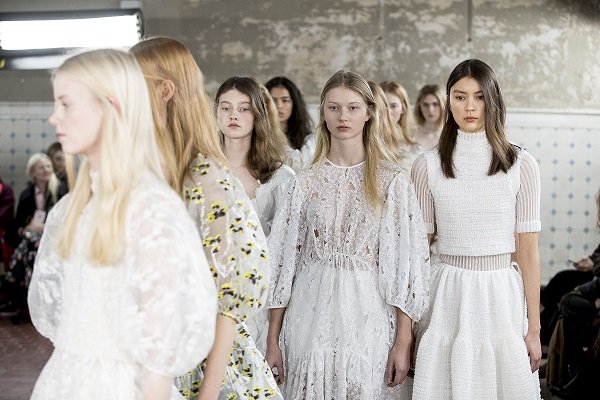The Ultimate Guide to Prairie Fashion: History, Trends, and How to Style It
Prairie fashion, an aesthetic deeply rooted in the history of the American frontier, has made its way into the world of modern fashion. The rustic charm of the prairie, with its vast landscapes and simple living, has influenced many designers and fashionistas, sparking a revival in recent years. From prairie dresses to lace-up boots, prairie fashion is a symbol of both nostalgia and practicality, blending old-world charm with contemporary trends.
In this ultimate guide, we’ll explore the history, evolution, and key elements of prairie fashion. We’ll also provide tips on how to incorporate this timeless style into your wardrobe, making it relevant for today’s trends. Whether you’re looking to channel your inner pioneer spirit or simply love the romantic and free-spirited vibe, prairie fashion is versatile and full of possibilities.
1. What is Prairie Fashion?
Prairie fashion is a clothing style inspired by the pioneers, settlers, and farmers of the American Midwest during the 19th century. The style is characterized by simple, functional pieces made from natural fabrics, with a focus on comfort and modesty. The dresses are often long and flowing, with lace details, ruffles, and high collars. Accessories such as bonnets, wide-brimmed hats, and lace-up boots are also central to prairie fashion.
2. The History of Prairie Fashion
Early Beginnings
The roots of prairie fashion can be traced back to the early days of the American frontier, specifically the 1800s. As settlers moved westward to establish homesteads, their clothing needed to be practical and durable, yet modest. Women wore long dresses made from wool, cotton, and linen, which were often layered for warmth and protection against the elements. These dresses featured high collars, long sleeves, and floor-length hems, designed to preserve modesty and offer comfort during long hours of work on the homestead.
Influence of the Prairie Life
Life on the prairie was demanding, with women performing various tasks like cooking, farming, and sewing. This practical lifestyle influenced the design of clothing, with an emphasis on functionality. For example, dresses were often paired with aprons or pinafores to protect the clothing underneath while working. Bonnets were worn to shield the face from the sun, and sturdy boots were essential for walking through rough terrain.
Transition to the Early 20th Century
By the early 1900s, prairie fashion had begun to evolve. The invention of new materials and changes in social norms led to a shift in styles. However, the essence of prairie fashion remained intact. The long, flowing dresses continued to be a staple, but they started to incorporate more delicate fabrics like lace, embroidery, and floral patterns. This created a softer, more romantic look that would become synonymous with the prairie aesthetic.
Prairie Fashion in the 1960s and 1970s
The prairie look experienced a resurgence in the 1960s and 1970s, particularly as part of the bohemian fashion movement. Designers like Laura Ashley embraced the romantic and ethereal qualities of prairie style, blending them with modern sensibilities.
3. Key Elements of Prairie Fashions

Prairie fashions is marked by several key elements that give it its distinct charm. These features blend practicality with romanticism, making prairie style both timeless and versatile.
1. Long, Flowing Dresses
One of the defining features of prairie fashion is the long, flowing dress. Typically made from light, breathable fabrics like cotton, linen, or chiffon, prairie dresses have high necklines, long sleeves, and ankle-length hems.
2. Ruffles and Lace
Ruffles and lace are iconic features in prairie fashion, adding a touch of femininity and romance to otherwise simple and utilitarian clothing. These details are commonly found on collars, cuffs, and hemlines.
3. Floral Prints
Floral prints are another hallmark of prairie style. These prints are usually small and delicate, reminiscent of wildflowers found in the prairie landscape. The floral patterns are often incorporated into dresses, skirts, and blouses, giving the wearer a soft, natural look.
4. Bonnets and Hats
To complete the prairie look, bonnets and wide-brimmed hats are often worn. These accessories serve both a functional and aesthetic purpose, protecting the wearer from the sun while enhancing the vintage charm of the outfit.
5. Lace-Up Boots
Footwear in prairie fashion is typically sturdy and practical.
6. Aprons and Pinafores
Aprons and pinafores are often worn over dresses to protect the clothing underneath while working. They also add an extra layer of charm to prairie fashion, particularly when made from gingham, cotton, or linen.
4. Prairie Fashion in Modern Times
The shift toward more sustainable and practical fashion has brought prairie-style clothing back into the spotlight. Designers and high-street brands have embraced the simplicity and beauty of prairie fashion, making it relevant for today’s fashion-conscious consumers.
1. Sustainable and Ethical Fashion
The growing interest in sustainable fashion has made prairie-style clothing more appealing. The natural fabrics used in prairie fashion, such as cotton, linen, and wool, align with current trends toward eco-friendly materials. The focus on simple, durable clothing is also in line with the movement toward more conscious consumption.
2. Bohemian Influence
Prairie fashion has strong ties to bohemian style, which has also seen a resurgence in recent years. The free-spirited nature of prairie fashion, combined with its focus on natural beauty and comfort, makes it a perfect fit for those who embrace boho-chic aesthetics.
3. Mainstream Runways
Designers such as Ralph Lauren, Isabel Marant, and Chloé have incorporated elements of prairie fashion into their collections, featuring flowing dresses, floral prints, and rustic accessories on the runway. These contemporary takes on prairie style blend vintage elements with modern silhouettes, making the prairie look accessible and stylish.
5. How to Style Prairie Fashion Today
Incorporating prairie fashion into your wardrobe doesn’t have to feel like a step back in time. With a few tweaks, you can give prairie-inspired outfits a modern edge. Here are some tips on how to style prairie fashion for today’s world:
1. Pair Prairie Dresses with Leather Jackets
To add a modern twist to a prairie dress, pair it with a leather jacket or a denim jacket. This contrast between soft and rugged creates a cool, stylish look that is both fashionable and functional.
2. Opt for Ankle Boots
While lace-up boots are a classic prairie look, ankle boots with a chunky heel are a great way to make your outfit feel more current. Choose a pair of boots in neutral tones like black or brown for maximum versatility.
3. Mix Prairie with Contemporary Pieces
Mix prairie-style dresses and blouses with contemporary items like tailored blazers or structured bags. This juxtaposition will help balance the softness of prairie style with modern elements, making the overall look feel fresh.
4. Experiment with Bold Accessories
Add some bold accessories to your prairie outfits to make them stand out. Consider wide-brimmed hats, statement earrings, or a vintage scarf. These details can take your prairie look from simple to striking.
6. Prairie Fashion for Different Body Types
Prairie fashion is a style that can be flattering for many body types, thanks to its relaxed and flowing silhouette. Here are some styling tips for different body shapes:
| Body Shape | Styling Tips |
|---|---|
| Pear-shaped | Look for dresses with a fitted waist and a flared skirt to balance proportions. A-line prairie dresses are perfect for highlighting the waist while allowing for freedom of movement. |
| Hourglass | Embrace dresses that cinch at the waist to accentuate curves. Choose high-neck styles and avoid overly voluminous skirts to maintain balance. |
| Apple-shaped | Opt for prairie dresses with an empire waist that sits just below the bust. This will help elongate your torso and provide a flattering silhouette. |
| Petite | Choose shorter prairie dresses or skirts that hit above the knee. Keep the look simple with minimal layers to avoid overwhelming your frame. |
| Plus-size | Look for dresses with a V-neckline and A-line silhouette to elongate the body. Empire waists and dresses with flowing skirts can help create a more balanced shape. |
7. Trending Prairie Fashion Items

As prairie fashion continues to evolve, there are several items currently trending. These pieces bring modern flair to the traditional prairie aesthetic:
- Smocked Dresses: These dresses feature gathered fabric that stretches to fit the body, creating a flattering and comfortable fit.
- Peasant Blouses: With their loose fit and billowing sleeves, peasant blouses are an essential prairie piece that can be paired with jeans or skirts.
- Tiered Skirts: Adding movement and flow, tiered skirts are a feminine and flattering option that can be dressed up or down.
- Floral Midi Dresses: The midi length is perfect for wearing prairie-inspired dresses year-round, making them versatile for different seasons.
8. Brands Embracing Prairie Fashion
Several contemporary brands have embraced prairie fashion, offering collections that evoke the charm of the frontier. Some of these brands include:
- Free People: Known for its bohemian-inspired clothing, Free People often incorporates prairie-inspired dresses and accessories into its collections.
- Anthropologie: Anthropologie’s vintage-inspired aesthetic is heavily influenced by prairie fashion, featuring lace, floral prints, and romantic silhouettes.
- Madewell: This brand blends modern simplicity with vintage charm, offering prairie-style dresses, skirts, and blouses with a contemporary twist.
- Reformation: Sustainable fashion brand Reformation frequently includes prairie-inspired pieces with a focus on eco-friendly fabrics and ethical production.
9. Key Designers and Influences
Key designers include:
- Ralph Lauren: Known for his American heritage style, Ralph Lauren often includes prairie-inspired pieces in his collections, combining Western motifs with refined elegance.
- Isabel Marant: Marant’s bohemian and folk-inspired collections often feature prairie-style dresses, blouses, and skirts with modern, feminine details.
- Chloé: This luxury brand blends prairie-inspired pieces with high-end materials and sleek designs, creating an elevated version of the rustic look.
10. Maintaining Prairie Fashions
To keep your prairie fashions items in great condition, follow these tips:
- Gentle washing: Use a gentle detergent and cold water to preserve the quality of your prairie dresses and blouses.
- Proper storage: Store your clothes in a cool, dry place to avoid damage from heat or humidity.
- Avoid over-drying: Air dry your prairie garments to maintain their shape and prevent shrinkage.
11. Pros and Cons of Prairie Fashions
Pros:
- Timeless and versatile
- Sustainable and eco-friendly materials
- Comfort and ease of movement
- Romantic and feminine aesthetic
Cons:
- Can be seen as too retro for some
- May require layering in colder weather
- Can be challenging to accessorize for a modern look
12. Conclusion
Prairie fashions is a charming and functional style that continues to captivate fashions lovers around the world. With its blend of rustic simplicity and romantic femininity, prairie fashions offers a timeless appeal that can be adapted for modern times. Whether you’re drawn to the vintage charm of prairie’s dresses or looking for ways to incorporate its elements into your wardrobe, prairie fashions offers endless possibilities.
13. Disclaimer
The information provided in this article is for informational purposes only. While we strive to provide accurate and up-to-date information, we do not guarantee the completeness or accuracy of the content. Always consult a professional stylist or fashion expert for personalized advice regarding prairie fashion.
